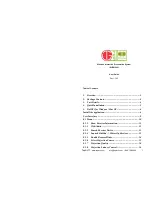
Falcon2 4M, 8M, and 12M Camera User's Manual
73
Teledyne DALSA
03-032-20107-03
9.
Click on
Save
. The flat field correction d ata is saved as a TIF im age w ith a file nam e of you r
choice (su ggestions are the cam era nam e and its serial nu m ber).
Using Flat Field Correction
When u sing Cam Exp ert, from the m en u bar enable Flat Field correction (Pre-Processing • Flat Field
Correction • H ard w are). Now w hen d oing a live grab or snap, the incoming image is corrected by the
current flat field calibration d ata for each pixel. Use the CamExpert menu fu nction Tools • Flat Field
Correction • Load to load in a flat field correction image from previously saved calibration d ata.
Cam Exp ert allow s saving and load ing calibration d ata for all cam eras u sed w ith the im aging system .
Uploading Coefficient to the Camera
Flat field coefficients can u p load ed to the cam era via the file access control featu res. The Flat Field
Coefficients File is a stand ard TIF file. A Sap era ap p lication (su ch as Cam Exp ert) creates a new Sap Bu ffer
object of the sam e w id th as the im age bu ffer bu t w ith tw ice the nu m ber of lines. This p rovid es the room
to store both offset and gain Flat Field d ata. The Flat Field offset d ata is contained in the top half of the
new bu ffer, w hile the gain bu ffer is in the bottom half.
A Sap era ap p lication saves the new bu ffer u sing Sap Bu ffer::Save w ith the "-form at tiff" op tion, w hich
allow s saving d ata w ithou t loss of significant bits.
Defective Pixel Detection and Replacement
The cam era has tw o m ethod s of rep lacing p ixels. Static p ixel rep lacem ent u ses the FFC coefficients to
m ark p ixels that w ill be rep laced . Dynam ic p ixel rep lacem ent consists of a m ed ian filter that is ap p lied
w hen the given p ixel is above a threshold w hen com p ared to ad jacent p ixels.
Static Pixel Replacement
This is a techniqu e for the elim ination of d ead or hot p ixels. A p ixel on the left ed ge (beginning of the
line) w ou ld be rep laced w ith the p ixel to its right, w hile a p ixel on the right ed ge (end of the line) is
rep laced w ith the p ixel to its left. Any p ixel w ithin a line is rep laced w ith the average of its neighboring
p ixels (on the sam e line). For color sensors, the sam e algorithm is u sed excep t the rep lacem ent p ixel is of
the sam e color. N ote that three horizontally ad jacent d efective p ixel cannot be rep laced .
The cam era u ses the FFC coefficients to ind icate w hich p ixels need to be rep laced . If a p ixel has a
Gain(PRN U) coefficient that is equ al to the m axim u m gain( i.e. ap p rox 1.5 for H igh resolu tion and 2 for
H igh Gain m od e then the p ixel w ill be m arked for rep lacem ent . Ad d itionally, a p ixel w ill be rep laced if
has an Offset(FPN ) coefficient that is greater than the p ixel rep lacem ent threshold
(
flatfieldCorrectionPixelReplacementThreshold
). Low ering this threshold w ill rem ove m ore p ixels w ith high
offset coefficients.
Most hot and d ead p ixels w ill be id entified w hen a FPN or PRN U calibration is p erform ed in cam era. The
u ser can also m anu ally m ark a p ixel for rep lacem ent by setting its Offset Coefficient to 127. After the flat
field calibration has been p erform ed , the u ser can increase the exp osu r e tim e, cover the sensor, and ru n a
p ixel rep lacem ent calibration (
flatfieldCalibrationPixelReplacement)
for m ore inform ation on w hy this need s to be d one.
The p ixel rep lacem ent calibration algorithm ad d s the new fou nd hot p ixels to the p ixel d efect m ap and
m u st be ru n after an offset calibration. If the d ifference betw een the average p ixel valu e and the stored
offset valu e(FPN coefficient) is greater than the calibration threshold (i.e.
flatfieldCalibrationPixelReplacementOffsetThreshold
)
then the p ixel is m arked for rep lacem ent. Typ ically, the
p ixel rep lacem ent calibration shou ld be ru n at the highest exp osu re tim e u sed in the target system . See
Ap p end ix D: Internal Flat Field Calibration Algorithm s for m ore inform ation on the algorithm .














































